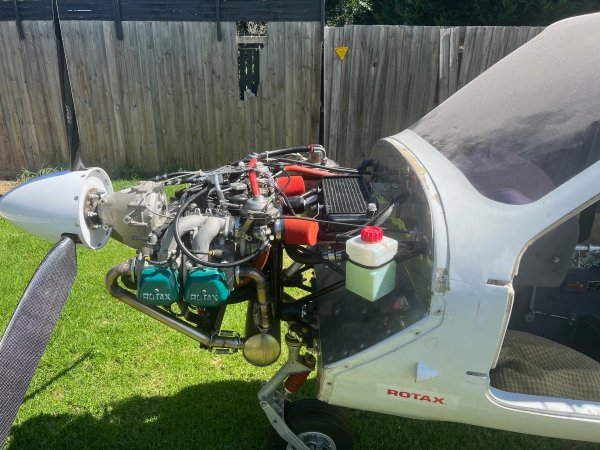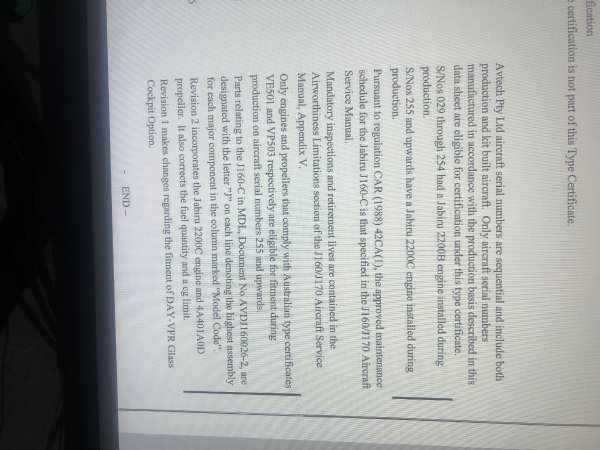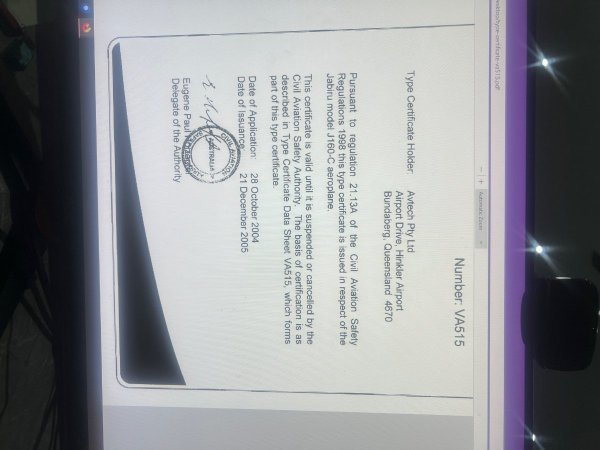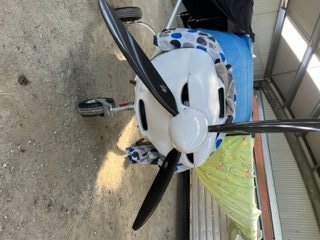-
Posts
38 -
Joined
-
Last visited
Content Type
Profiles
Forums
Gallery
Downloads
Blogs
Events
Store
Aircraft
Resources
Tutorials
Articles
Classifieds
Movies
Books
Community Map
Quizzes
Posts posted by GolfWhiskeyHotel
-
-
On 10/04/2024 at 3:48 PM, facthunter said:
GWH did you even try to check up anything before you wrote that your man is an expert and that Hydrogen embrittlement is not an issue?
If he hasn't taken the trouble to do a bit of research HE"S NOT an expert. Welding wet or stripping plating or even electroless plating can cause embrittlement Hydrogen in storage under pressure causes it in pipes and containing vessels This IS a safety matter regardless of whether some one you know doesn't bother about it. CASA had an extensive article on it. What you have said is irresponsible. I hope you can see that. Now i'm going to get another bloody argument that shouldn't be happening. Nev
FFS . I have been in this eng. game for 60+ years. If I say he's and expert , he is , and that includes knowledge of embrittlement. ....I dont anticipate armchair commentators to start questioning my posts. Thank you.
-
14 hours ago, Blueadventures said:
Have you looked at the drawings in the back of the manual I posted in the Skyfox section for Gazelles?
I have printed the drawings but they're illegible, too small to help. I can see the bearing, its drawn mounted on the bare leg. Looks like its pinned to the outer sleeve , would that be correct? How about the discs that proved the springing? what are they? I've got hard rubber bar from my Jodel u/c rebuild , Shore 70, it may be too hard. Thanks anyway. Cheers , Geoff
-
25 minutes ago, facthunter said:
Chroming stuff can cause Hydrogen Embrittlement. Don't do it on load carrying parts unless treated properly post plating (and not long after). Nev
I get motorcycle fork legs hard chromed all the time. No problems there. About $200 per leg! Leg is ground -chromed -ground.......... they're experts
-
 1
1
-
 1
1
-
-
Working on a Gazelle, replacing the front tyre I pull the tail down and check the front leg. It wobbles a bit . the leg itself (the inner tube) was chromed that's now gone in places, there is up and down "slop" I read about biscuits in the manual , does not say what they are. How are the bearings in the outer leg arranged? Is it just a spring in a tube? Does anyone have a working drawing of the leg? Any help much appreciated.
Thanks
GWH
-
31 minutes ago, turboplanner said:
The thrust lines can be measured on the finished aircraft using plumb bobs and datums.
We did that when building the engine mount!...to no avail. If the thrust line was out more than a couple of mm's the trim would require alteration shirley, plus the prop shaft would rub on the cowl.
-
OK, so two years and $45000 later , We have a flying ( under a special temporary C of A. ) Rotax powered J160. Now approaching 40 hours of faultless operation. All within 50 miles of home! The aircraft is also deemed so unsafe as to not qualify for RAA insurance coverage , It was reported to me that " Examining Engineers" cant even be çertain that the thrust line is correct! (The elevator trim lever remains in the original position )
The aircraft is thus unregisterable under all present groups ( 24, 19 ect ) .... It appears that a major fault was not providing identities and details of similarly powered Jabirus. Plus wandering too far from the original spec. (Also a major sticking point. )
I did make appeals to people with Rotax/Jabs on here and other forums..... . But only a single photo or spec sheet was forthcoming. I had a couple of promises and some knockbacks. one positive result, not enough .... The RAA of course MUST know who built them and have photographic evidence. But they don't share.
As things stand I CAN fly the Jab, within a 50 miles radius. Within a temp C of A ....But there are no circumstances or pathways to registration ATM. Thus flying further than I can see is not possible. To say I am disappointed would be the understatement of the century. at 77 years old 2 years is a big chunk. My immediate instinctive response is to burn the Jab and L2 cert. and walk away. It's unsaleable and I cant afford another. .... I am trying to find a positive. Not there yet..... Flying is still flying.
The point of this all.? BEWARE OF MARAP. You can invest Lots Of Time and Money and have NO control.
-
 1
1
-
-
On 13/02/2024 at 11:27 PM, Area-51 said:
Sure glad I can use a pencil map compass and timepiece!!
So what other electronic options are there remaining 🤷🏼♂️
AvPlan
-
Just received this rather drastic email. Amber Aviation is the Lessor of Tooradin Airfield on the SE outskirts of Melbourne.
What does the team think? is this the way to increase traffic or?
-
 1
1
-
-
after more than 60 years putting engines together I will ONLY use Yamaha Threebond ( I believe all Threebonds are the same) painty it on both surfaces, let it "go off" for 15minutes or so. No leaks, Ever. Loctite Master Gasket has failed me more than once. Never again. (Goes very hard and flakes off separated surfaces)
Cheers.. G
-
 1
1
-
 1
1
-
-
I just tried searching for Stolspeed.com on "Bing" "Google" "Firefox" on my phone and on my PC. all I get is "unable to access this site"
There's something going on. I've been trying for a few weeks......I'll try someone else's pc...............G
-
 1
1
-
-
That really weird , I just get the standard blank page "we are having trouble finding that site" I'll try a different search engine.
-
 1
1
-
-
Does anyone know what has happened to the Stolspeed website? Or does anyone have a telephone number for the owner?
-
-
In the middle of our MARAP application, 5 months in, just about 20 hours on the beast. Flies like a Jabiru 160 with a bit more power. Cowling mods finished , Got the water and oil temps up to a reasonable level, Blanking off the top cowl openings seem to have given us about 5 knots, But that may be wishful thinking I cant really see where that could have come from ( better engine temps maybe) . Someone asked me why I hadn't just changed to E24 Reg. I couldnt give an exact answer, so looked it up in the technical manual online. Now I am more confused than ever. The Jab 160c is a certified aircraft. Needs Marap for modifications. OK , Doesn't actually say that But OK. . However Page 6.1 section 8 through 9 goes on to explain the process to having it E-LSA registered. Does anyone actually KNOW , according to the Tech manual , Why, when I have no intention or requirement to teach in the aircraft, have to go through this complex process. It's difficult to understand and I fear that I have bitten off more than I can chew. I'm close to walking away from it and the RAA.. Just too difficult to deal with... Cheers, G
-
Its oK someone else is transporting the aircraft!
I'm off the hook.
But I had decided to go Via Temora , Narrabri, ( or similar ) Casino then up the coast and along the VFR corridor then along the Island VFR corridor turn left to Caboolture.
-
In the planning stage now. Probably Saturday dep. BUT looking at the map around Brisbane, What a mess of Military and controlled airspace. How the hell does one find a way through that lot. We're looking at a route
Tooradin-Wang-Temora-Narromine-Dalby-Caboolture. Over two days weather permitting. Can anyone tell us the best route to negotiate Controlled and Military airspace on the last leg.
-
3 point how many litres for 110hp? That's really not good enough. If fact it's not a lot different to a Continental 0-200.......
So it's going to burn about the same as the 0-200. That's just sad. Why would a manufacturer bother. All they're doing is diluting the present market. Unless there's some magic
property that I have missed or haven't heard of yet. 30 something hp per litre. wow. (in little letters) A postie bike puts out about 75 bhp per litre. They can't do better than that?
Back to the Rotax....-
 2
2
-
 1
1
-
-
Thank you everyone for the input. I don't like putting weight in the tail. But there was nothing to move. The aircraft weighs 6 kilos more than original and 2.5 of that is tail ballast. I could use a much heavier battery ( 12? kilos ) and place it behind the seat next to the fuel tank, then run much heavier cables next to the fuel tubing down the centre of the fuselage. That would be adding considerable lbs to the total weight..... If I did the job again I would put the engine and inch closer to the firewall and alter the cowling. If anybody needs the measurements I am quite happy to supply, The aircraft flies straight and level with the tailplane horizontal. It can also climb at a frightening angle. Not been solo yet, but I estimate 2000 ft per min to be a realistic number. it also runs a bit too cool, I could have used a smaller radiator, smaller air scoop and carried less water. Next time I'll know. Thanks again. Geoff
-
 1
1
-
 1
1
-
-
11 hours ago, facthunter said:
Moving a mass within the CofG range cannot move it out of the range. Moments are a force (weight)x Distance from a designated point. The datum chosen is often ahead of the plane itself. If you chose the mid distance of the desired Cof G as a datum as a practice run.it would be more easy to understand with Plus and minus moments leaving some residual.. Like balancing a see saw. Otherwise you need a table giving the moment range for any given total wt. I've always preferred a graphical presentation as it's more intuitive. It's better if you UNDERSTAND what is happening all the way rather than just some Table of numbers. That's my take on it and hope it helps. Nev
I took your advice and found a J160 W&B sheet. It seems all may be well. What do you think? And thanks for the solid advice. G
-
 1
1
-
-
10 hours ago, skippydiesel said:
One small point - If it transpires you do need more weight adft, than your existing battery (LiPo ?) will supply, what's stopping you using a heavier battery (lead acid?) ?
THis is true, The battery in question is LIFEP04 not lipo. The problem lies in normal battery weight 7 - 10 kgs. and the position available is some way behind the seats. That may be too much of a good thing!
-
 1
1
-
-
2 hours ago, kiwiaviator said:
Battery may be 'light' however moving it from forward of datum to rear of datum can make a difference. You can use Ozrunways W&B to do what if's. You can add new stations easily. If you do add weight near the tail, you need to be mindful of structural limitations as there is 'less aeroplane' back there.
400 grams a foot in front or behind the c of g will make no difference
-
23 minutes ago, facthunter said:
Is the battery located forward? it's often used to achieve balance. You'll have to go back to studying W & B and understand the basic principles. Have you got a basic weight and index figure?. Nev
Battery is so light as to make no difference. I have necessary weight and balance sheets. (Attached here) I can see how to calculate aircraft index units. But I want to know how to calculate backwards so to speak , or how to achieve lower Aircraft Index Units by a known amount. For example ; adding 1 kilo to arm at -3750mm (tail) moves C of G rearwards by ? mm. I'm not a maths expert. I can guess, but I want to KNOW. Cheers
-
50 minutes ago, 440032 said:
My question first would be how do you have a 24 registered (factory built type accepted) Jabiru - with a Rotax in it?
Go to MARAP. jump thru required hoops, fly aeroplane
-
 1
1
-
 1
1
-
-
Now my Jabiru / Rotax project is nearing completion there is a matter I would like to correct. That is the C of G. placement. Jabiru say that the forward limit of a (at MTOW) J160 should be 233mm behind the wing L.E.
After I had the weight and balance done I see that the C of G is at 217mm behind the L.E. the question is How much weight do I add at the tail end to move the C of G 30mm rearward. I have all the calculation values at hand , I just dont know how to calculate the value. Weight 2.pdf








Front Leg
in Skyfox/Gazelle
Posted
OK True. .... NO IDEA of your qualifications or experiences........ Nor have you of mine. ........and I did "Even Try" ( your expression wound me up as it inferred lackadaisical behaviour ) to check yes....... And Hydrogen embrittlement is a well known phenomenon in the industry. However, I have dealt with thousands of fork legs and shafts and NEVER seen or heard of a fork leg suffering that type of breakage. Even under extreme usage. So while it happens, it's not common.
However , I have had personal experience of a zinc plated special bolt 5/8" unf breaking at hand pressure! High carbon steels ( with a hardness above 40 Rockwell) are susceptible to cracking if not correctly heat treated after plating.